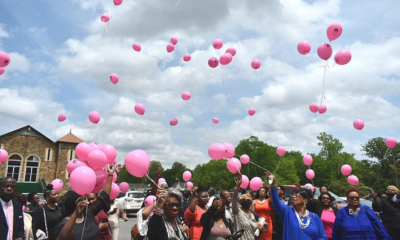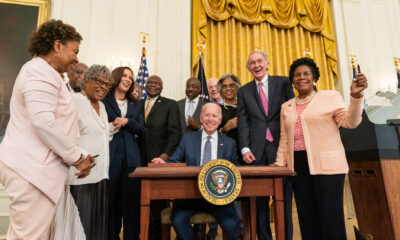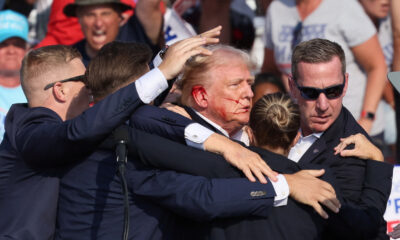News
The Black Family: Reviewing Its Roots

The most visible African American family for the last nine years lives in the White House. President Barack Obama and First Lady Michelle along with their two daughters are the traditional nuclear family. They are also singlehandedly challenging the narrative of the dysfunctional Black family. From Hollywood to Harlem, this picture of a healthy family is being studied.
Sociologist Veronica Newton says, “I do think the Obamas have redefined what it means to be a Black family, and I do think that having them as the First Family dispels myths about Black parents. They do set a positive image and tone for African Americans.”
The prevailing idea of the Black family as dysfunctional is often traced to the Moynihan Report written in 1965 by Daniel Patrick Moynihan who worked as the Assistant Secretary of Labor for President Lyndon Johnson. The report received widespread criticism for citing the rise of Black single motherhood as a hindrance to the progress of the Black family.
According to Newton, the Moynihan Report did not “take into account the impact of systemic racism of Black families in terms of jobs and housing discrimination (which go hand-in-hand) which influences whether or not there are ‘eligible’ spouses for marriage.”
She continues, “We also have to look at crime and over-policing in Black neighborhoods which disproportionately targets Black men, explaining why Black men are incarcerated at very high rates and often for petty crimes. This leaves Black women with few Black male options for potential husbands.”
An examination of the Black family takes us back to the plantation. Slaves were not allowed to enter contracts, and marriage is a contract. There were ceremonies to honor their union even if it did not bear the approval stamp of the state. In some instances, the master supported the ritual known as “jumping the broom” and considered it good business: a “married” couple might forego opportunities to escape.
Slaves lived and loved in the shadow of the constant threat of separation. Often, their “marriages” were torn asunder by a master who sold the husband or wife. In some cases, the children were sold, disrupting their emotional well-being and rupturing the family unit.
“Many people don’t know that the traditional nuclear family is a Western European phenomenon and that Black families in pre-colonial Africa did not have nuclear families or have ‘traditional gender roles’”, Newton explains. “Pre-colonial African families were not organized around conjugal (nuclear families), they were organized around consanguineal cores which were composed of compounds or groups formed by adult siblings of the same sex or large same sex segments of matriarchal or patriarchal lineages.”
In the aftermath of the Civil War, Black families seized the chance to establish family units independent of the slave owners’ whims. Because many were unable to find blood relatives sold during slavery, they turned to friends and others with whom they had formed relationships and created a familial base that allowed them a sense of community.
 They moved to different towns in search of a fresh start. During Reconstruction, some enjoyed a sense of citizenship, voting to elect African American men to office. There were towns founded by Black Americans that provided financial stability and opportunities for business ownership. But, the insidious evil of racism morphed into a cruel system known as Jim Crow that kept its hateful grip on Black Americans through the Civil Rights Movement.
They moved to different towns in search of a fresh start. During Reconstruction, some enjoyed a sense of citizenship, voting to elect African American men to office. There were towns founded by Black Americans that provided financial stability and opportunities for business ownership. But, the insidious evil of racism morphed into a cruel system known as Jim Crow that kept its hateful grip on Black Americans through the Civil Rights Movement.
The Moynihan Report came along during the tumultuous 60’s as Black America fought for its voting rights along with other rights long denied. Many saw the report as another White indictment of Black America. Interestingly enough, when Moynihan released the report in 1965, a review of the 1960 Census revealed that 74 percent of African American homes included two parents. Fifty years later in 2010, that number had declined to 44 percent.
“I would also argue that the way we see Black family structures now (single headed households) isn’t exactly new if we take into consideration the structure of pre-colonial African families. Black families are still adapting and assimilating to the whitecentric family structure that we were forced to assimilate to during and after enslavement,” explains Newton.
The beloved family of four living at 1600 Pennsylvania Avenue is a point of pride for most Black Americans. Because of the Obamas’ status class and educational background, they may be considered outliers to the rest of the country. But, what is clear to all after their almost 10 years on display is their strong sense of family, a tradition valued and embraced in the community to which they belong.
Vickie Newton is the Founder of TheVillageCelebration and the host of the magazine’s podcast. Vickie is an award-winning broadcast journalist and a Mass Communications Instructor at The University of Arkansas at Pine Bluff, a Historically Black College & University. And while Vickie enjoyed writing this article about the family, she and Sociologist Veronica Newton are not related.

-

 Featured10 months ago
Featured10 months agoCalifornia Is the First State to Create A Public Alert for Missing Black Youth
-

 Featured9 months ago
Featured9 months agoAfrican American Leaders Stay the Course Amid Calls for President Biden To Bow Out of Race
-

 Featured10 months ago
Featured10 months agoThe Debate Fallout Lands on Both Candidates
-

 Featured9 months ago
Featured9 months agoPresident Joe Biden Decides to Withdraw from the Presidential Race
-

 Featured9 months ago
Featured9 months agoIn One of His Final Speeches as President, Biden Says It’s Time for ‘Fresh Voices’
-

 Featured9 months ago
Featured9 months agoPresident Joe Biden Describes Shooting of Donald Trump As ‘Sick’









